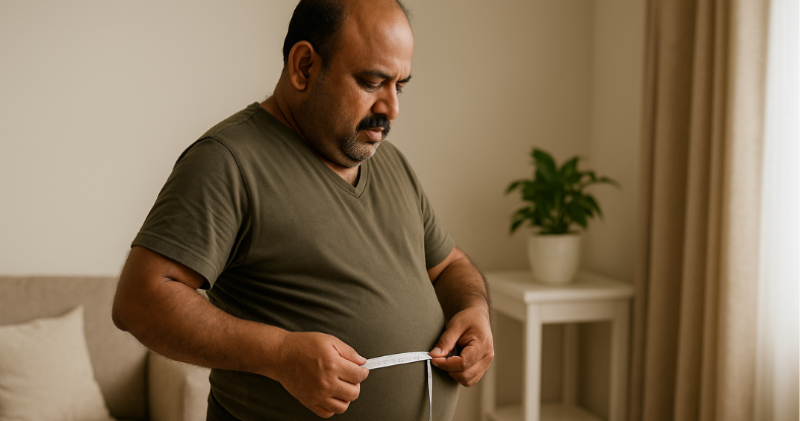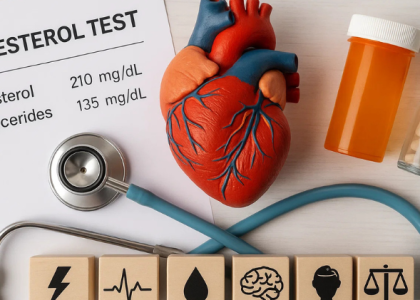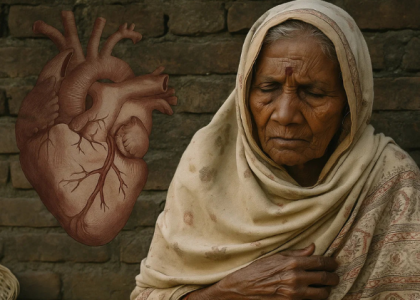The Most Important Number You’re Not Measuring
Ask most people how they track their health, and they’ll mention weight or BMI. But if you’re South Asian, those numbers can be misleading. You might have a “normal” body weight and still carry a dangerous type of fat around your belly — the kind that leads to heart attacks, diabetes, and high blood pressure.
Here’s the good news: you don’t need a lab test or a fancy device to find out your risk.
All you need is a soft measuring tape — and 2 minutes.
Why Waist Size Matters More Than Weight for South Asians
South Asians — including Indians, Pakistanis, Sri Lankans, and Bangladeshis — tend to store more fat inside the abdomen, around the organs. This is called visceral fat, and it doesn’t always show on the outside. That’s why many people who “don’t look fat” are still at high risk for heart disease.
Weight and BMI (Body Mass Index) don’t show where your fat is. Waist circumference does.
Medical research now confirms: waist size is a better predictor of heart disease risk for South Asians than BMI alone.
How to Measure Your Waist at Home — The Right Way
Here’s a simple step-by-step guide. Don’t worry — you don’t need to be a fitness expert.
What You Need:
- A soft measuring tape: like a tailor’s tape
- A mirror: optional, but helpful
- 2 minutes of your time
How to Measure:
- Stand straight, feet shoulder-width apart. Remove bulky clothes or measure over a thin T-shirt.
- Find your natural waist: usually just above your belly button (not your hips).
- Wrap the tape around your waist level: snug, but not tight. Make sure it’s parallel to the floor all the way around.
- Exhale normally, then check the number where the tape meets.
Done! That’s your waist circumference.
Know the South Asian Cutoffs
Waist size matters more for us than the general population. Here’s what doctors now recommend:
| Gender | Danger Zone Starts At |
|---|---|
| Men | 90 cm (35.4 inches) |
| Women | 80 cm (31.5 inches) |
For comparison, Western guidelines often use 40 inches for men — but South Asians face risks at smaller waistlines due to differences in body fat patterns.
Even if your weight is “normal,” a waist above these limits increases your risk for:
- Heart attack or stroke
- High blood pressure
- Type 2 diabetes
- Fatty liver disease
Quick At-Home Clues (Even Without a Tape)
Don’t have a tape yet? These signs also suggest high belly fat:
- You can’t see your toes when standing up straight
- You feel pressure in your stomach after meals
- You breathe heavily when tying your shoes
- Your jeans feel tight at the waist but loose at the legs
Why Belly Fat Is More Dangerous Than You Think
Most of us think of fat as something you can pinch — but the most harmful fat is hidden inside. Visceral fat:
- Wraps around your organs
- Releases inflammatory chemicals
- Increases insulin resistance
- Raises cholesterol and blood pressure
This type of fat is especially common in South Asians — and it doesn’t show up on the scale. That’s why waist size is your early warning system.
3 Things to Do If Your Waist Is in the Danger Zone
If you’re over the recommended waist size, don’t panic. You can make progress without extreme diets or workouts. Start here:
- Reduce Simple Carbs: Cut back on white rice and replace half with brown rice, millets, or cauliflower rice. Avoid sugar in tea, sweets, and packaged foods — these feed belly fat.
- Walk After Every Meal: A 15-minute walk after lunch or dinner lowers blood sugar and reduces belly fat storage. This is especially helpful if you’re older or don’t exercise regularly.
- Track Your Waist Every Month: Re-measure your waist monthly and write it down. Even 1–2 inches lost around your belly can mean a big drop in risk.
Conversation Starter: Ask Your Doctor
At your next visit, say: “Can we talk about my waist size and belly fat risk? Should I get a calcium score or advanced lipid test like Lp(a)?”
This shows you’re proactive — and helps your doctor tailor your care.
Final Thought
Your waist size is more than a number — it’s a window into your future health. And for South Asians, it’s often the first warning sign long before cholesterol or sugar tests show a problem.
Measuring your waist isn’t about appearance. It’s about protecting your heart, your energy, and your time with loved ones. It takes 2 minutes and could add years to your life.
So grab that measuring tape — and take your first step toward a healthier future.




